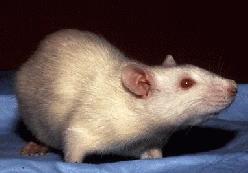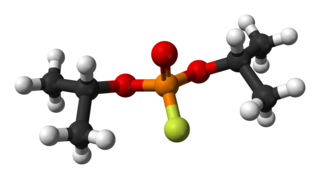Related Research Articles
CNS may refer to:

Laboratory rats or lab rats are strains of the rat subspecies Rattus norvegicus domestica which are bred and kept for scientific research. While less commonly used for research than laboratory mice, rats have served as an important animal model for research in psychology and biomedical science.

Dubin–Johnson syndrome is a rare, autosomal recessive, benign disorder that causes an isolated increase of conjugated bilirubin in the serum. Classically, the condition causes a black liver due to the deposition of a pigment similar to melanin. This condition is associated with a defect in the ability of hepatocytes to secrete conjugated bilirubin into the bile, and is similar to Rotor syndrome. It is usually asymptomatic, but may be diagnosed in early infancy based on laboratory tests. No treatment is usually needed.

Crigler–Najjar syndrome is a rare inherited disorder affecting the metabolism of bilirubin, a chemical formed from the breakdown of the heme in red blood cells. The disorder results in a form of nonhemolytic jaundice, which results in high levels of unconjugated bilirubin and often leads to brain damage in infants. The disorder is inherited in an autosomal recessive manner. The annual incidence is estimated at 1 in 1,000,000.

Uridine 5'-diphospho-glucuronosyltransferase is a microsomal glycosyltransferase that catalyzes the transfer of the glucuronic acid component of UDP-glucuronic acid to a small hydrophobic molecule. This is a glucuronidation reaction.

Diisopropyl fluorophosphate (DFP) or Isoflurophate is an oily, colorless liquid with the chemical formula C6H14FO3P. It is used in medicine and as an organophosphorus insecticide. It is stable, but undergoes hydrolysis when subjected to moisture.

Lucey–Driscoll syndrome is an autosomal recessive metabolic disorder affecting enzymes involved in bilirubin metabolism. It is one of several disorders classified as a transient familial neonatal unconjugated hyperbilirubinemia.

UDP-glucuronosyltransferase 1-1 also known as UGT-1A is an enzyme that in humans is encoded by the UGT1A1 gene.
There are at least four known endothelin receptors, ETA, ETB1, ETB2 and ETC, all of which are G protein-coupled receptors whose activation result in elevation of intracellular-free calcium, which constricts the smooth muscles of the blood vessels, raising blood pressure, or relaxes the smooth muscles of the blood vessels, lowering blood pressure, among other functions.

In medicine, bilirubinuria is an abnormality in which conjugated bilirubin is detected in the urine.
Biobreeding rat, also known as the BB or BBDP rat, is an inbred laboratory rat strain that spontaneously develops autoimmune Type 1 Diabetes. Like the NOD mice, BB rats are used as an animal model for Type 1 diabetes. The strain re-capitulates many of the features of human type 1 diabetes, and has contributed greatly to the research of T1D pathogenesis.

UDP-glucuronosyltransferase 1-6 is an enzyme that in humans is encoded by the UGT1A6 gene.

UDP-glucuronosyltransferase 1-4 is an enzyme that in humans is encoded by the UGT1A4 gene.

Hereditary hyperbilirubinemia refers to the condition where levels of bilirubin are elevated, for reasons that can be attributed to a metabolic disorder.
Najjar is an Arabic and Sephardic surname and profession meaning carpenter. Notable people with surnames Najjar, al-Najjar, or al-Najar include:
Hemopressin (Hp) is an alpha hemoglobin fragment with the sequence PVNFKFLSH, originally identified in extracts of rat brain using an enzyme capture technique. It binds cannabinoid receptors, acting as an inverse agonist at CB1 receptors. Longer forms of hemopressin containing 2-3 additional amino acids on the N-terminus have been identified in extracts of mouse brain. These longer hemopressin peptides, named RVD-Hpα and VD-Hpα, bind to CB1 receptors and were originally reported to be agonists. In addition to the Hp peptides from alpha hemoglobin, a related peptide from beta hemoglobin has been found in mouse brain extracts; this peptide, named VD-Hpβ, is also an agonist at CB1 cannabinoid receptors. Hemopressin is not an endogenous peptide but rather an extraction artefact. The only endogenous peptide found endogenously at physiological conditions is RVD-hemopressin (pepcan-12), which has more recently been shown to be a negative allosteric modulator of CB1 receptors and positive allosteric modulator of CB2 receptors. RVD-hemopressin (pepcan-12) is generated from a pro-peptide called pepcan-23 and these peptides are exclusively found in noradrenergic neurons in the brain and in the adrenal medulla.

Ida Stephens Owens was an American scientist known for her work with drug-detoxifying enzymes. She received her Ph.D from Duke University in 1967, making her one of the first two African Americans to receive a doctorate from the school. She spent her career at the National Institutes of Health (NIH), where she worked from 1968 to 2017 and pioneered the study of the genetics of human diseases and drug metabolism.
Crigler may refer to:
Victor Assad Najjar (1914–2002) was a Lebanese-born American pediatrician and microbiologist at the Johns Hopkins Hospital, Vanderbilt University and Tufts University. Along with John Fielding Crigler, Najjar is known for Crigler–Najjar syndrome.
John Fielding Crigler was an American pediatrician. Along with Victor Assad Najjar, Crigler is known for Crigler–Najjar syndrome. He studied medicine at the Duke University School of Medicine, graduating in 1943. He trained in pediatrics at Boston Children's Hospital.
References
- ↑ "Crigler-Najjar Syndrome: The Gunn rat". criglernajjar.altervista.org.
- ↑ Mukherjee, Anil B.; Krasner, Joseph (1973). "Induction of an Enzyme in Genetically Deficient Rats after Grafting of Normal Liver". Science. 182 (4107): 68–70. ISSN 0036-8075. JSTOR 1736242.
- ↑ Souba, Wiley W.; Wilmore, Douglas W. (2001-01-25). Surgical Research. Academic Press. p. 624. ISBN 978-0-12-655330-7.